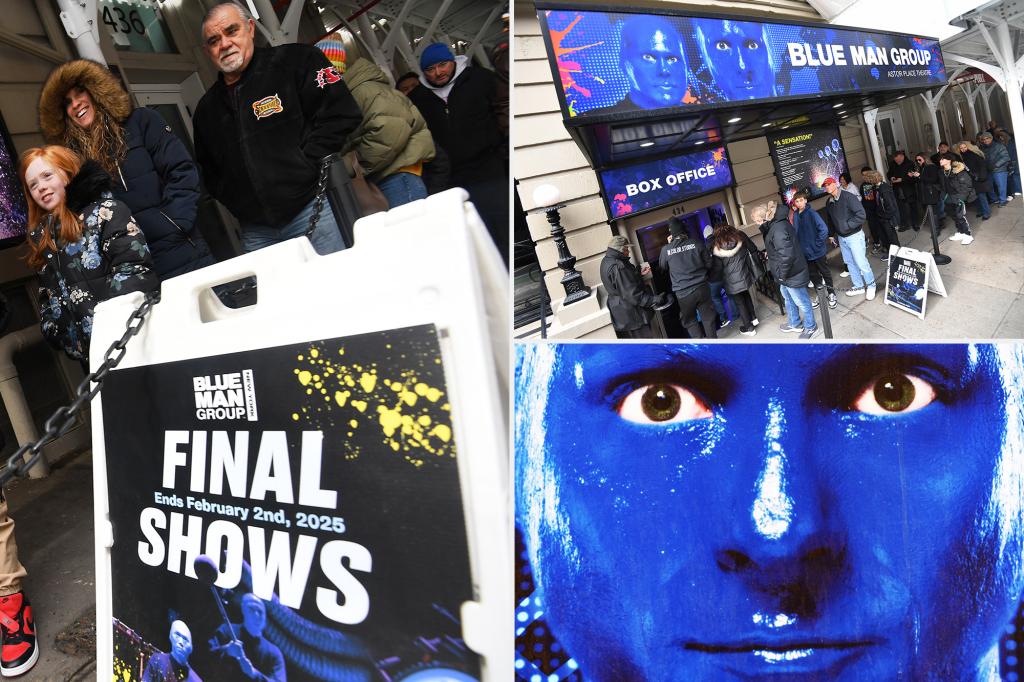The final curtain fell on the Blue Man Group’s New York City residency, leaving a void in the hearts of countless fans who flocked to the Astor Place Theater for one last vibrant, paint-splattered performance. After 34 years and over 17,000 shows, the iconic trio of blue-painted, bald, and mute performers took their final bow in their hometown, eliciting tears and a resounding standing ovation from a packed house adorned with blue beanies in homage to their beloved entertainers. The air was thick with emotion as the audience, many of whom had grown up with the Blue Man Group, recognized the significance of the moment – the end of an era, the departure of a treasured New York institution.
The final performance resonated with a unique intensity, amplified by the shared understanding that this was a farewell. Fans described an atmosphere charged with emotion, a palpable connection between the performers and the audience, both acknowledging the bittersweet nature of the occasion. The Blue Men, though traditionally expressionless, seemed to convey a sense of gratitude and perhaps even a touch of melancholy, while the crowd responded with fervent applause, cheers, and tears. For many, the final show surpassed all others, the emotional resonance adding a layer of depth to the already captivating performance. The energy exchange between the performers and their devoted fans created a memorable, moving tribute to a long and successful run.
The Blue Man Group had become interwoven with the fabric of New York City, a cherished part of its cultural landscape. For some, it held personal significance, marking milestones and memories. First dates, family outings, and even marriage proposals unfolded against the backdrop of the rhythmic drumming and mesmerizing visuals. The group’s unique brand of entertainment transcended language and cultural barriers, offering a shared experience that resonated with people of all ages and backgrounds. The sudden realization of their absence left many fans with a sense of loss, a feeling of saying goodbye to a familiar friend. The closing of the New York show marked a significant shift, a reminder of the ephemeral nature of even the most enduring traditions.
The Blue Man Group’s journey began in New York City in 1991, quickly achieving phenomenal success that led to expansion across the country and internationally, with shows in Boston, Orlando, Las Vegas, and Berlin. The acquisition by Cirque du Soleil in 2017 further broadened their reach, solidifying their position as a global entertainment phenomenon. News of the New York closure in November prompted a frantic rush for tickets, with fans determined to witness the final hometown performance. The swift sell-out highlighted the enduring popularity and deep connection the Blue Man Group had cultivated with their New York audience.
The reasons behind the decision to end the New York and Chicago runs remain unclear, adding to the sense of mystery surrounding the group’s departure. While other locations will continue to host performances, the closure of these long-standing residencies represents a significant shift in the Blue Man Group’s trajectory. The absence of the Blue Men from New York City’s vibrant arts scene leaves a void that will undoubtedly be felt by both residents and tourists alike. The iconic Astor Place Theater, so closely associated with the blue trio, will now host new acts, but the echoes of rhythmic drumming and splashing paint will surely linger.
The Blue Man Group’s final New York performance resonated deeply with those in attendance, leaving an indelible mark on their memories. It was more than just a show; it was a farewell to a cherished piece of New York City’s cultural identity. The shared experience of witnessing the final curtain fall created a sense of community among the audience, a collective acknowledgement of the group’s profound impact. For many, the Blue Man Group represented a time of innocence and wonder, a connection to a more carefree era. The heartfelt tributes and outpouring of emotion underscored the enduring legacy of the blue-painted performers, a legacy that will continue to resonate even in their absence. The final show was not just an ending, but a celebration of a unique and unforgettable phenomenon that touched the lives of millions.

